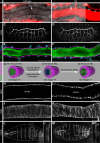Conserved function of the matriptase-prostasin proteolytic cascade during epithelial morphogenesis
- PMID: 30601807
- PMCID: PMC6331135
- DOI: 10.1371/journal.pgen.1007882
Conserved function of the matriptase-prostasin proteolytic cascade during epithelial morphogenesis
Abstract
Extracellular matrix (ECM) assembly and remodelling is critical during development and organ morphogenesis. Dysregulation of ECM is implicated in many pathogenic conditions, including cancer. The type II transmembrane serine protease matriptase and the serine protease prostasin are key factors in a proteolytic cascade that regulates epithelial ECM differentiation during development in vertebrates. Here, we show by rescue experiments that the Drosophila proteases Notopleural (Np) and Tracheal-prostasin (Tpr) are functional homologues of matriptase and prostasin, respectively. Np mediates morphogenesis and remodelling of apical ECM during tracheal system development and is essential for maintenance of the transepithelial barrier function. Both Np and Tpr degrade the zona pellucida-domain (ZP-domain) protein Dumpy, a component of the transient tracheal apical ECM. Furthermore, we demonstrate that Tpr zymogen and the ZP domain of the ECM protein Piopio are cleaved by Np and matriptase in vitro. Our data indicate that the evolutionarily conserved ZP domain, present in many ECM proteins of vertebrates and invertebrates, is a novel target of the conserved matriptase-prostasin proteolytic cascade.
Conflict of interest statement
The authors have declared that no competing interests exist.
Figures






Similar articles
-
Evidence for a matriptase-prostasin proteolytic cascade regulating terminal epidermal differentiation.J Biol Chem. 2006 Nov 3;281(44):32941-5. doi: 10.1074/jbc.C600208200. Epub 2006 Sep 15. J Biol Chem. 2006. PMID: 16980306
-
Prostasin is required for matriptase activation in intestinal epithelial cells to regulate closure of the paracellular pathway.J Biol Chem. 2013 Apr 12;288(15):10328-37. doi: 10.1074/jbc.M112.443432. Epub 2013 Feb 26. J Biol Chem. 2013. PMID: 23443662 Free PMC article.
-
The matriptase-prostasin proteolytic cascade in epithelial development and pathology.Cell Tissue Res. 2013 Feb;351(2):245-53. doi: 10.1007/s00441-012-1348-1. Epub 2012 Feb 18. Cell Tissue Res. 2013. PMID: 22350849 Review.
-
Insights into the regulation of the matriptase-prostasin proteolytic system.Biochem J. 2020 Nov 27;477(22):4349-4365. doi: 10.1042/BCJ20200630. Biochem J. 2020. PMID: 33094801
-
Matriptase-dependent cell surface proteolysis in epithelial development and pathogenesis.Front Biosci. 2007 Sep 1;12:5060-70. doi: 10.2741/2448. Front Biosci. 2007. PMID: 17569630 Review.
Cited by
-
The proteolysis of ZP proteins is essential to control cell membrane structure and integrity of developing tracheal tubes in Drosophila.Elife. 2023 Oct 24;12:e91079. doi: 10.7554/eLife.91079. Elife. 2023. PMID: 37872795 Free PMC article.
-
Control of tissue morphogenesis by the HOX gene Ultrabithorax.Development. 2020 Mar 2;147(5):dev184564. doi: 10.1242/dev.184564. Development. 2020. PMID: 32122911 Free PMC article.
-
Prognostic Genomic Markers of Pathological Stage in Oral Squamous Cell Carcinoma.Head Neck Pathol. 2023 Jun;17(2):409-421. doi: 10.1007/s12105-022-01516-8. Epub 2022 Dec 31. Head Neck Pathol. 2023. PMID: 36586077 Free PMC article.
-
Sulfation affects apical extracellular matrix organization during development of the Drosophila embryonic salivary gland tube.bioRxiv [Preprint]. 2025 Aug 18:2024.11.20.624565. doi: 10.1101/2024.11.20.624565. bioRxiv. 2025. PMID: 40631256 Free PMC article. Preprint.
-
Membrane-anchored serine proteases as regulators of epithelial function.Biochem Soc Trans. 2020 Apr 29;48(2):517-528. doi: 10.1042/BST20190675. Biochem Soc Trans. 2020. PMID: 32196551 Free PMC article. Review.
References
Publication types
MeSH terms
Substances
LinkOut - more resources
Full Text Sources
Other Literature Sources
Molecular Biology Databases
Research Materials
Miscellaneous

